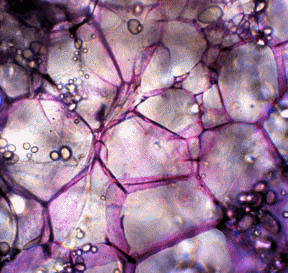 Parenchyma cells
Thin–walled parenchyma cells from the tuber of an Irish (white) potato, stained with toluidine blue. The granules within the individual cells are starch grains.
Parenchyma cells
Thin–walled parenchyma cells from the tuber of an Irish (white) potato, stained with toluidine blue. The granules within the individual cells are starch grains.
Parenchyma is composed of large thin walled cells usually with a single large vacuole. They are found in soft parts of the plant such as in cortex (outer region) and pith (central region) of roots and stem.
These cells are living. Parenchyma cells are the most abundant of cell types and are found in almost all major parts of higher plants. Parenchyma cells perform most of the metabolic functions of the plant, synthesizing and storing various organic products.
For example, some parenchymatous cells, particularly in the leaf, contain chloroplasts. They then, form a tissue called chlorechyma (chloros: green), which helps the leaf to produce food. Some parenchyma cells in stems and roots have colorless plastids that store starch. They store food and also provide temporary support to the plant. Potatoes are mainly composed of parenchyma cells. Parenchyma cells and tissues comprise most of the edible portions of fruit. Most parenchyma cells retain the ability to divide and differentiate into other types of plant cells under special conditions.